Photography in Yosemite National Park – Tips for the Traveling Photographer
by Alex W.
Long before the days of extravagant, mirrorless cameras and social media sharing, there was an awe-struck and enthralled adventurous photographer and environmentalist named Ansel Adams. Armed with a Kodak Brownie camera, Adams traipsed through the park’s iconic summits and valleys, snapping photos that would eventually assist in the growth of the National Park system. His photography in Yosemite truly changed the entire country.
Adams believed that “a true photograph need not be explained, nor can it be contained in words.” And few other landscapes illustrate that sentiment quite like his first love, Yosemite National Park. The reality is, Yosemite’s grandeur, magic, and unequivocal beauty are just plain hard to put into words – that’s why sometimes it’s easier to let the photographs do the talking.
Looking for some tips to practise in Yosemite? Check out our Ultimate Guide to Landscape Photography eBook!
One thing is certain, there’s something for everyone in Yosemite. Regardless of whether you’re a hobbyist with a camera phone, a novice, or professional photographer, Yosemite is a place that allows you to stretch your imagination and put together compositions that are far more than just perfectly crafted collections of images.
Photography in Yosemite is truly like nothing else, so here’s how to make the most of your time.
Off on your travels? Make sure to check out our guide to photography in Banff here.
Contents
Photography in Yosemite – Top Spots to Shoot
Yosemite Valley
Yosemite Valley draws millions of visitors from all around the world. Open year-round, the Valley’s accessibility and grandeur make it a photographer’s playground.
It’s the perfect place to start your Yosemite photography journey.
There are far too many scenic turnouts, short hikes, and jaw-dropping views to name here, but we put together a few Yosemite Valley highlights you’ll definitely want to add to your list.
Tunnel View
If you think of landscape photography in Yosemite, the chances are that you think of this vista.
Tunnel View has been the most photographed, painted, and appreciated viewpoint in the park since the 1930s. Iconic is an understatement.
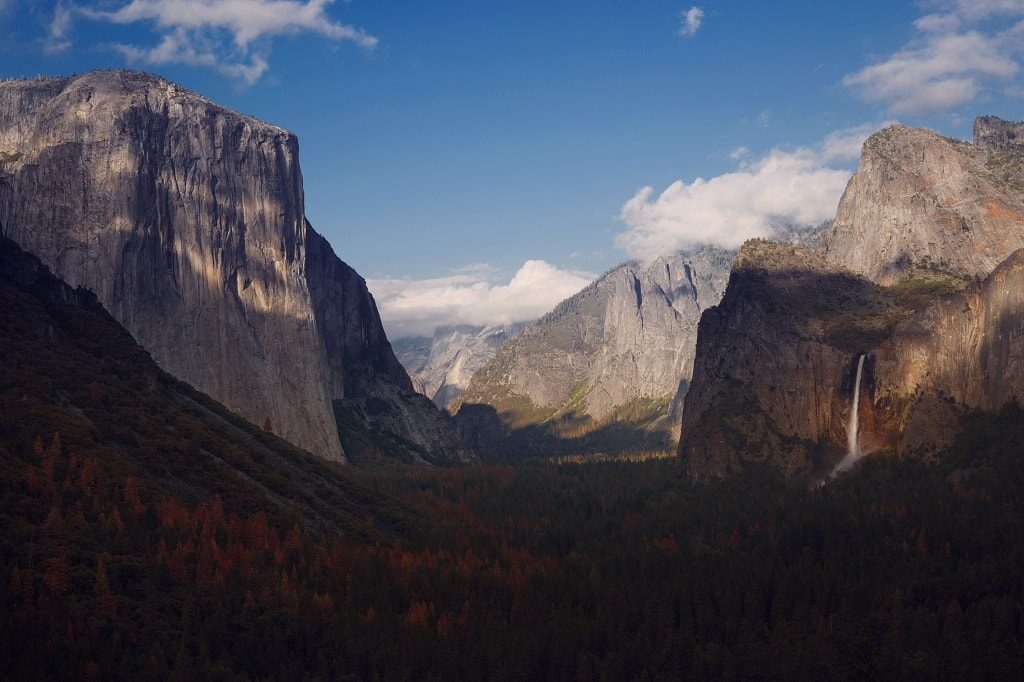
This is the vista, painted pink from the setting sun, that adorns the backdrop of Apple computers and Samsung smart TVs. It’s the first image you’ll see thumbing through the pages of a Yosemite travel guide and is at the top of the list for ‘must-sees’ in the Golden State.
Picture-perfect and postcard-worthy, Yosemite’s most beloved viewpoint is sure to leave a lasting impression. It goes without saying, but this viewpoint is notoriously crowded. If you don’t want to bump elbows with other photographers or selfie-stick wielding tourists, arrive at sunrise or trek up the mountainside to Inspiration Point for unobstructed, panoramic views.
El Capitan
Driving through the valley, the first impressive, smooth-faced granite monolith that will capture your attention is El Capitan.
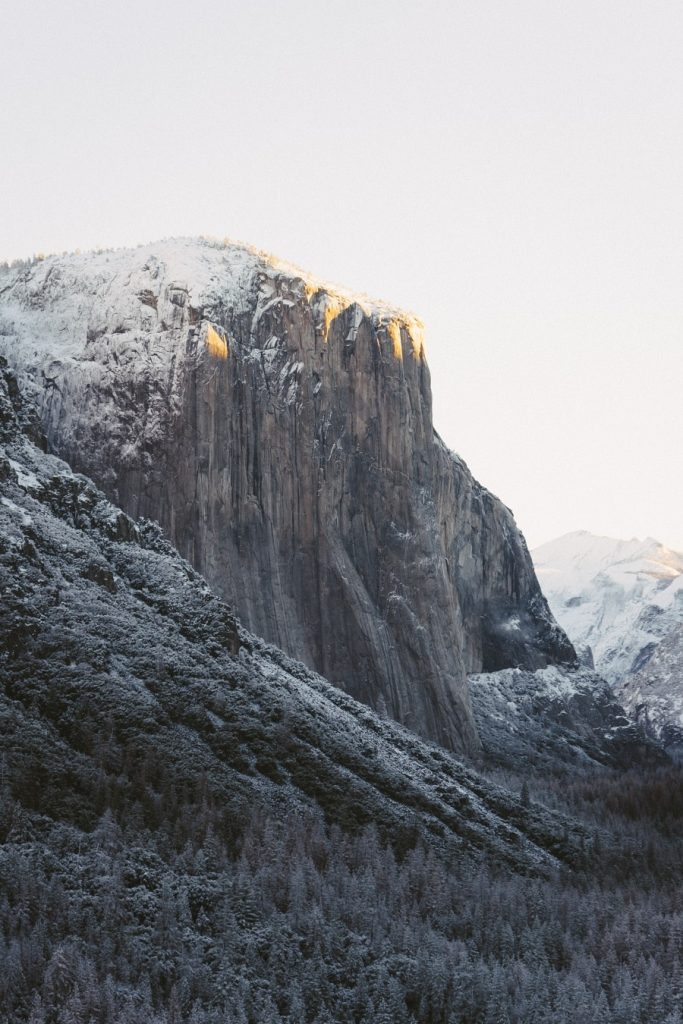
Towering 3,000 vertical feet above the valley floor, El Cap is a dramatic, dominating figure of the valley. It’s humbling size and picturesque location make it an ideal candidate for both sunrise and sunset.
Some of the best views of El Cap can be found at El Capitan Meadows, Tunnel View, the Cathedral Picnic Area, and Valley View. There are also several scenic locations along the Merced River that emphasize El Cap’s sheer rock face, so it’s worth packing your boots and taking a walk.
Three Brothers
Three granite peaks sit unassumingly to the east of El Cap, in the heart of Yosemite Valley – Eagle Peak, Middle Brother, and Lower Brother. Known as the Three Brothers, these peaks are said to have been a muse to John Muir.
Though they aren’t as easily spotted throughout the valley as El Cap or Half Dome, these stunning stacked peaks act as the perfect subject for a striking image.
The best view of the Three Brothers is near Tahiti Beach. At sunrise or sunset, when the Merced River is calm, you can capture the reflection of the peaks in the river below.
Half Dome
In terms of infamy, Half Dome is El Cap’s partner in crime. This oddly-formed, semi-circle-esque peak is a real crowd-pleaser, particularly at sunset.
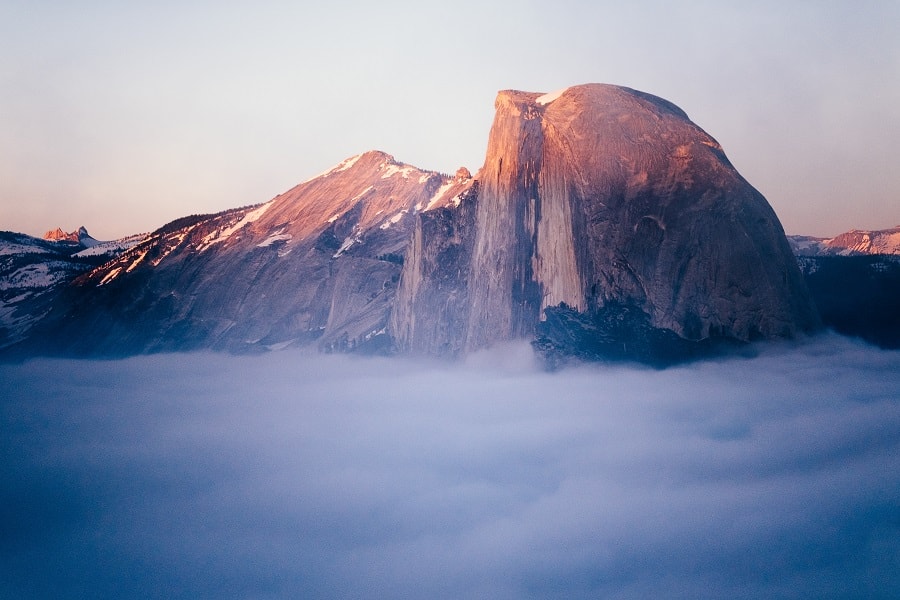
As you peer at the quirky features of Half Dome through your lens, don’t forget to channel your inner Ansel Adams, who, at the prime age of 14, snapped some of the very first recognizable images of this monolith with his Kodak Box Brownie.
This moment, you could say, was the birth of photography in Yosemite.
Popular vantage points and scenic vistas of Half Dome include Tunnel View, Mirror Lake, Sentinel Bridge, and Cook’s Meadow. If you only have time for a single sunrise in the park, make the trip to Glacier Point, where you can photograph the first light of the day as it illuminates the High Sierras and crests Half Dome.
Note: Glacier Point Road typically opens to motor vehicles in May and is accessible until October or November.
Mariposa Grove
Sure, Yosemite is known for its granite goliaths. But some folks don’t know that the south side of the park also houses the largest sequoia grove in Yosemite.
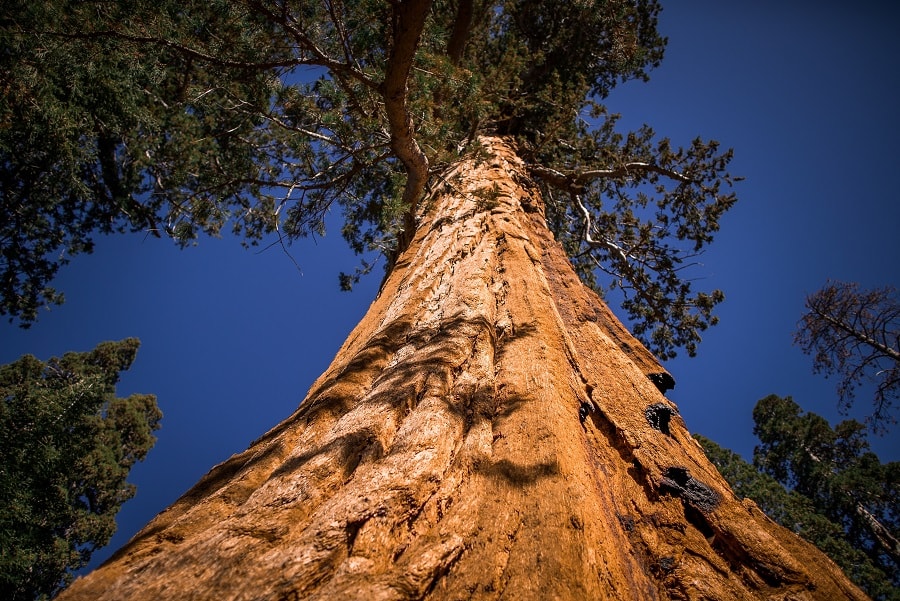
Over 500 mature sequoias can be found in the Mariposa Grove of Giant Sequoias, two of which are among the largest in the world.
Pack your wide-angle lens and creativity, capturing a 200-foot tree might take some time and ingenuity – but the photo potential is endless beneath these tall trees.
Tuolumne Meadows
Photographers and outdoor enthusiasts generally refer to Tuolumne Meadows as the heart of the High Sierras. Though you won’t find any of “classic” Yosemite icons in Tuolumne, if you’re looking to create unique and compelling images of Yosemite that haven’t been replicated a thousand times, Tuolumne is the place to be.
Tuolumne is one of the largest high-elevation meadows in the Sierra Nevada and is best described as a peaceful, calm, and serene place to shoot. If you’re willing to strap on your boots, consider trekking a short distance on the John Muir Trail to Cathedral Lakes. Though you’ll have to put in a little more effort than infamous views in the valley, the reward is a less-trafficked, granite-wrapped high-altitude lake with dazzling reflections.
Horsetail Falls/FireFall
Once upon a time, in the 1800s, a raging bonfire was built at the edge of Glacier point, 3,200 feet above Yosemite Valley. At 9 p.m., spectators would gather in Curry Village to watch as the glowing embers of that fire were hurled over the mountain to the valley below.
Fortunately for everyone, including the fire-prone park, this man-made firefall was ended in 1968.
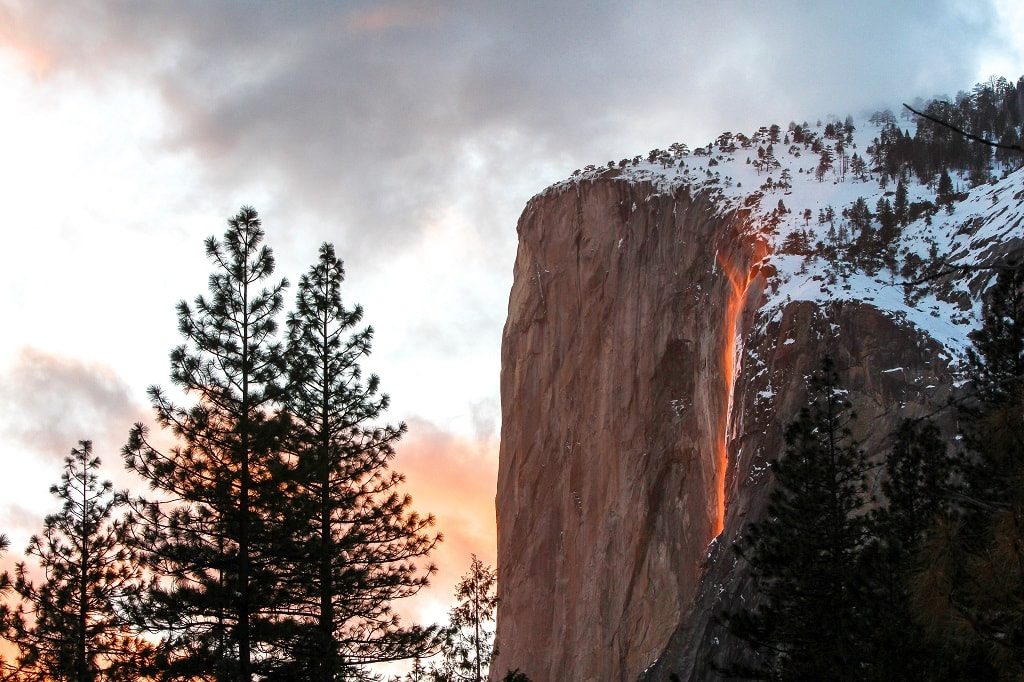
Fortunately, if you want to experience a less dangerous firefall variety, a natural firefall still takes place almost every year. In late February, thousands of photographers flock to Yosemite Valley to capture a natural phenomenon that appears to set Horsetail Fall on fire.
While some photographers leave glowing with excitement, others leave disappointed. Firefall is entirely on Mother Nature’s schedule and the conditions have to be perfect. I like to think that the utter uncertainty is really what makes firefall so special and definitely worth the effort.
When to Visit Yosemite National Park
It’s hard to say there’s a better or worse time to visit Yosemite. It sounds cliche, but the park literally transforms from season to season and there’s never a shortage of stunning scenery.
To be honest, photography in Yosemite can easily be a year-round endeavour.
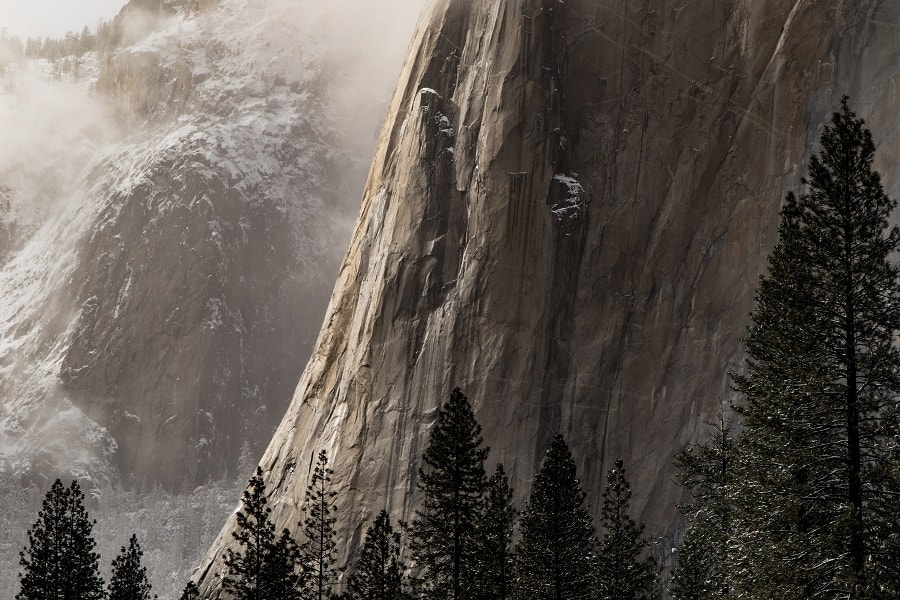
However, if you can’t make it for all four seasons, consider what you’re looking to photograph and weigh the following pros and cons:
Summer – July, August, September
Pros
- Warm, clear summer nights are perfect for astrophotography
- Seasonal park roads will be open (i.e. Taft Point and Glacier Point), so you can explore more of the park
- A few more accommodations and amenities available to visitors
- Longer days make for more opportunities to explore and take photos
Cons
- Extremely crowded. It’s not a matter of if you’re going to get stuck in traffic, it’s a matter of when.
- The tour buses are running. Pack your patience – You won’t find a lot of peace and quiet unless you venture out at sunrise.
- When the weather warms up, most of the waterfalls dry up, so if you’re looking to chase waterfalls, summer isn’t the time to visit.
- A lot more planning required – Reservations for campgrounds and hotel accommodations get reserved 6 months in advance.
Winter – December, January, February
Pros
- Goodbye crowds. This is easily the slowest season for photography in Yosemite.
- Hello winter wonderland. From the quaint, snow covered Chapel to the blanketed Valley floor, the park completely transforms into the type of ethereal snowscape you’d find in a snowglobe.
- As winter winds down in late February, you have better odds of capturing the infamous Firefall.
Cons
- Both Glacier Point road and Tuolumne Meadows are closed for the season.
- Weather can be unpredictable.
- There will be fewer accommodations and amenities available to visitors.
Fall/Autumn – September, October, November
Pros
- The park puts on an incredible display of fall colors offering one of the very best leaf-peeping opportunities in the Sierras.
- The weather is relatively mild and much cooler than in the summer
- Far less crowds than you’ll find in spring or summer
Cons
- Catching the changing leaves is unpredictable, so if you arrive too late, the park will appear dry and colorless
- Tuolumne Meadows and Glacier Point may not be accessible, depending on weather conditions
Spring – March, April, May, June
Pros
- As the park starts to thaw out, waterfalls, streams, and foliage gets new life and will be at their peak in the Spring.
- Blue-purple Lupines, poppies, mountain dogwood, and other wildflowers decorate the Valley.
- Although park visitation starts to increase, it’s still much less crowded in the Spring than in the Summer.
- Depending on winter conditions, Glacier Point road and Tuolumne Meadows may open for the season in mid-May.
Cons
- Winter might hang out for a little bit longer making weather unpredictable.
- Don’t count on Glacier Point road and Tuolumne Meadows being open, they’re entirely on Mother Nature’s schedule.
Recommended Gear
Lenses
Click here to find all our recommended Best Lenses for Landscape Photography.
Wide-Angle: If you’re looking to capture it all in one frame – the peaks, the valleys, the vastness – a wide-angle lens will do the trick. The granite monoliths in Yosemite Valley, in particular, are the perfect place to practice playing around with scale and unique foregrounds.
Recommended Lens: Tamron 15-30mm f/2.8 Di VC USD G2
-
Tamron SP 15-30mm F/2.8 Di VC USD G2 for Canon Digital SLR...
- Super high-quality high-speed ultra-wide-angle zoom lens
- Lens has triple lens coatings consisting of the newly developed ax coating, plus band and bar coatings
Telephoto: If you own a telephoto, it wouldn’t hurt to throw it in your camera bag. Some of the most unique characteristics of the park can be captured by getting up close and personal with the subject. A telephoto lens is perfect for snapping photos of climbers scaling El Cap, a fox roaming the valley floor for food, or to compress a distant peak to illustrate its immense scale.
Recommended Lens: Tamron 70-200mm f/2.8 Di VC USD G2
-
Tamron SP 70-200mm F/2.8 Di VC G2 for Nikon FX DSLR (6 Year...
- VC performance is 5 stops (VC mode 3) and offers three modes optimized for different shooting situations
- MOD reduced to 37.4" (1:6.1 max. mag. Ratio). Angle of view (diagonal): 34°21' - 12°21'(for full-frame format), 22°33' - 7°59'(for APS-C format)
Primes: Yosemite is a popular destination for outdoor weddings and events, and it’s easy to see why. The park is incredibly accessible and offers the perfect backdrop for portraits and photojournalistic moments. There is plenty of space to move around and capture the perfect composition and perspective, making the park perfect for playing with prime lenses.
Click here to see why we love prime lenses!
Recommended Lens: Sigma 50mm f/1.4 ART
-
Sigma 50mm F1.4 Art DG HSM Lens for Canon
- 50mm focal length
- 75mm equivalent focal length on APS-C cameras, 80mm equivalent focal length on Canon APS-C cameras
Misc. Items
Extra batteries: There’s nothing better than warm, summer nights capturing the milky way over the valley. Unless, of course, your camera is at 10% and you can’t lock in the settings fast enough. There is simply too much to see and do, to leave your battery life to chance.
Polarizing Filter: Yosemite is infamous for its beautiful, bright sunny days and reflection perfection. A polarizing filter will help balance out your images by reducing glare and giving them a little extra boost of contrast.
Tripod: For long exposures that’ll make Yosemite Falls silky smooth, capturing pin-sharp pictures of Yosemite icons, or for late night adventures to Glacier or Taft Point.
Struggling to find the right tripod? Check out our Ultimate Guide to Buying a Tripod here. Or, just take our word for it and buy the Vanguard Alta Pro 2+ below!
-
Vanguard Alta Pro 2+ 263AP Aluminum Tripod with Alta PH-32...
- MACC (Multi-Angle Center Column) for limitless shooting angles with firm hexagonal center column that offers one handed, effortless smooth operation and rapid set-up
- Position versatility - 3 section legs with 4 position angles - 20°, 40°, 60°, 80° and rock solid positioning - unique “locked” to “unlocked” twist leg lock system
Read More…
Photography in Banff National Park
Best Camera Bags for Photographers
Best Cameras for Landscape Photography
Ultimate Guide to Landscape Photography
 |
 |
 |
 |

About Alex W.
Alex is the owner and lead writer for Click and Learn Photography. An avid landscape, equine, and pet photographer living and working in the beautiful Lake District, UK, Alex has had his work featured in a number of high profile publications, including the Take a View Landscape Photographer of the Year, Outdoor Photographer of the Year, and Amateur Photographer Magazine.
Thoughts on "Photography in Yosemite National Park – Tips for the Traveling Photographer"
 |
 |
 |
 |
You can Get FREE Gifts. Furthermore, Free Items here. Disable Ad Blocker to receive them all.
Once done, hit anything below
 |
 |
 |
 |




